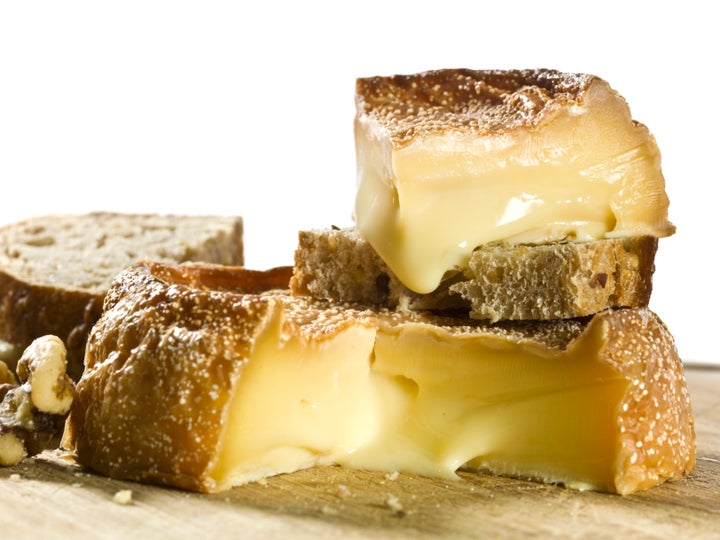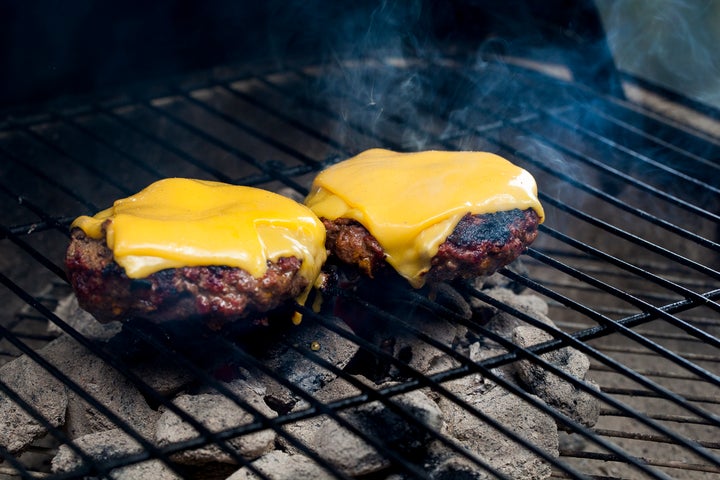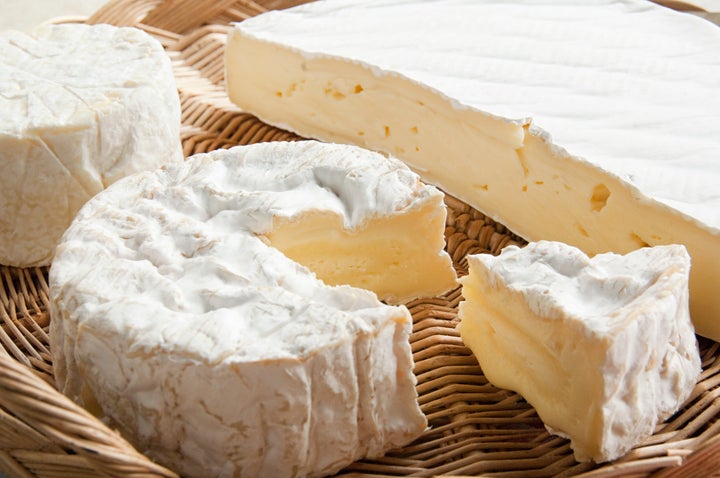Kraft American slices are delicious, but that’s not your only option.
The cheeseburger has long been an American staple. The subject of iconic music and even a major movie plot point, these dairy-topped patties are easy enough to make ― just add cheese to a regular burger.
But when it comes to the type of cheese you choose, there’s a range of options that can affect the quality of the dish in many ways.
“A burger can go in so many different directions,” said James Whitehead, executive chef at Seaworthy in New Orleans. “Basically, you want to go either high-brow with characterful and divisive cheeses, or super low-brow with mild, familiar flavors like American and Muenster.”
We asked Whitehead and other culinary experts to share their favorite cheeses for cheeseburgers. Keep scrolling for some exciting options and combinations of cheeses to inspire your next cookout or spice up a regular weeknight dinner at home.
Toma
“I’ve never understood why folks put lousy cheese on burgers,” said Janet Fletcher, publisher of the Planet Cheese blog. “It’s a cheeseburger, people. The cheese matters. Using a tasty one takes no more effort, and it’s the difference between a ‘meh’ burger and a memorable one.”
She recommended the TomaTruffle from Point Reyes Farmstead Cheese Co. for a melty, flavorful option. It’s a semihard cheese made from pasteurized cow’s milk and aged for 90 days.

Sharp Cheddar
“For a traditional burger topped with lettuce, tomato and a creamy mayo, I like to opt for a sharp cheddar as opposed to American,” said “MasterChef” alum Lexy Rogers. “The bitterness in a sharp cheddar cuts through the fat of the burger and adds dimension no matter what quality beef you use.”
Cookbook author Brian Theis is also a fan of sharp cheddar and recommended Cracker Barrel Extra Sharp Yellow Cheddar, along with pickle relish for “an added bonus.” Lola Osinkolu, a home cook and blogger for Chef Lola’s Kitchen, endorsed Sargento sliced sharp natural cheddar cheese to bring lots of richness and tanginess to a burger.
“It melts perfectly, and I like how it pairs perfectly with the savory flavors of a cheeseburger,” she said.
Pepper Jack
“For a slightly less traditional burger, I like to top my burgers with pepper jack cheese for a little heat, but also stuff them with a creamier slightly sharp cheese like goat or feta,” Rogers said.
The chef used pepper jack in a burger recipe for her cookbook “Break Bread on a Budget,” and as a money-minded cook, she recommended Walmart’s Great Value brand for price and quality.
“If I were doing a Tex-Mex burger, I’d certainly always add a melted pepper jack with a nice scoop of guacamole and red onions,” Theis added.
Époisses
“If I’m adding bacon to my burger, then I’m going to go for the slightly stinky, slightly smoky Époisses,” said Laura Werlin, a James Beard Award-winning author of six books on cheese. “This thick and creamy wonder is almost like a pre-melted cheese.”
She touted the hearty cow’s milk cheese’s ability to stand up to high heat without completely disappearing into the meat and compared it to Taleggio.
“Bacon or no bacon, Époisses makes one of the best, most satisfying, and most memorable cheeseburgers in the entire pantheon of cheeseburger possibilities,” Werlin said.

Fontina
Fontina is a semihard cow’s milk cheese that originally comes from Italy. Werlin recommended a similar cheese called Wagon Wheel from California’s Cowgirl Creamery.
“It’s kind of like fontina, which itself is a legendary melting cheese,” she said. “The most important criterion when choosing a cheese for a burger is that the cheese has enough personality to stand up to the beefiness beneath it. This cheese has just that.”
“Our beloved burger [at Seaworthy in New Orleans] has more of a classic, casual feel, so we opt for a simple, square-cut slice of fontina that melts easily and doesn’t detract from the housemade tomato jam, crispy pancetta or pickle remoulade,” Whitehead said.
American Cheese
“I’m a traditionalist when it comes to a cheeseburger, so American cheese all the way,” said Alex Hill, a home cook and creator of the blog Just Add Hot Sauce. “Yes, it is processed but it has the best meltability for a cheeseburger and the mild but perfectly salted cheese reigns supreme and [complements] a good juicy burger. I’m a Kraft American cheese girl!”
It’s indeed hard to beat the nostalgia and comfort of a cheeseburger with American cheese.
“Having grown up in Long Island and in the diner business, my gold standard is always the classic American cheese for its creamy yet not [overpowering] taste,” said Stella Drivas, a recipe developer and creator of the food blog Hungry Happens. “You want the burger meat to have center stage here. American cheese is also the better choice since it melts quicker than most other cheeses and thus you won’t overcook your meat waiting on the melt.”
Even the restaurant world has embraced this old standby to help high-quality beef flavors shine.
“We are big fans of Kraft American,” said Shannon Bingham, executive chef at Devil Moon BBQ and Brewery Saint X in New Orleans. “Since we’re a barbecue restaurant, we like to get big blocks of cheese and cold smoke them before slicing to give some good backyard BBQ flavor to our griddled burgers. Cheddar, gouda and provolone are also great options for this technique.”
Although you might not guess from the name, the national chain Emmy Squared Pizza is known for its decadent burger, and CEO Howard Greenstone credits the simple addition of two slices of American cheese for helping to achieve the perfect blend of ingredients.
“The Sammy sauce on the burger is an assertive flavor, so American cheese is the perfect [complement] to both the meat and the sauce,” he noted. “American cheese is creamy, melty, and beautifully balances the meat and sauce. We are looking for a cheese to [complement] the flavor and not overpower it.”

Comté
“Thicker backyard- or restaurant-style burgers invite more options, and I lean toward Alpine cheeses,” said Tyler Akin, chef-partner at Le Cavalier at the Green Room in Wilmington, Delaware. “Comté and raclette melt more slowly than American, matching the longer cooking times required by a thicker patty. The more elastic texture when melted also helps maintain the structure of a larger cheeseburger, holding it all together so it doesn’t crumble apart.”
Werlin believes certain ingredient combinations call for a melty Alpine cheese. If she’s adding grilled onions, she opts for a French or Swiss cow’s milk option like Comté or Gruyère.
“These often have roasted onion-like flavors, so why not gild the lily?” she said. “Most of all, these cheeses have legendary melting properties along with flavors like brown butter, roasted nuts, the aforementioned roasted onion, so they bring a level of flavor and complexity that a cheese-less burger simply won’t have with or without the addition of grilled onions.”
For a similar mountain cheese from the U.S., she recommends the Whitney product from Jasper Hill Farms in Vermont and Pleasant Ridge Reserve from Uplands Cheese Company in Wisconsin. Both melt nicely while maintaining their great flavors.
Mozzarella
“For all the mozzarella lovers out there, there’s a reason we love it on pizza but rarely see it on burgers,” Werlin said. “It has little flavor. Even still, for some people, texture matters more than flavor when it comes to their burger. In that case, the oozy, stretchy qualities of mozzarella can’t be beat even if the burger is a lot harder to eat because of it!”
Dzung Lewis, a YouTuber and author of “The Honeysuckle Cookbook,” also offered mozzarella as a solid option for a cheeseburger.
“When choosing cheese for burgers, I always go with something with a higher moisture content for that gooeyness that we love,” she explained. “So a softer cheese like mozzarella or provolone would work well.”

Young Cheddar
“While we all love aged cheddar, it’s harder to love on a burger,” Werlin said. “‘Aged’ is the operative word here because while the cheddar will usually melt, it often separates. In turn, it becomes a grainy mess and may not even adhere to the burger.”
She recommended a younger, milder cheddar for a cheese with higher moisture and a more “bendy” rather than “crumbly” quality on a burger.
“Cheddar is always a good option too, but a younger age like Tillamook, aged for 60 days, would melt better than a mature cheese aged more than one year because I’ve found those to not only take longer to melt, but they also come out a bit crumbly too,” Lewis echoed. “You can’t beat a classic cheddar cheeseburger, and I always go with Tillamook medium slices, or Whole Foods even carries this hickory smoked cheddar for a deeper cheesy flavor that is perfect for a bbq cookout.”
Akin is a fan of the Cooper Sharp brand for a dependable option, while Fletcher enjoys a spicy cheddar like Beehive Cheese’s Red Butte Hatch Chile.
Brie
“If I’m looking for something a little more elevated, a gourmet restaurant-style burger, I love adding a slice of melty brie and some sautéed mushrooms into my burger,” Lewis said. “Brie melts surprisingly well and adds so much flavor to the burger.”
As always, the goal is to ensure the cheese works with the vibe of the dish as a whole.
“A soft brie cheese can create a creamy, indulgent texture,” O’Brien noted. “It’s essential to choose the cheese that [complements] the flavor profile of the burger and enhances the overall eating experience.”
Werlin prefers avoiding brie as a cheeseburger topping because it liquifies and oozes too much for her, but she suggested other ways to incorporate this cheese, like stuffing it into the meat patty before cooking.
“Using melted brie ― sans rind ― as a dip for that burger or spreading the melted cheese on the bun after the burger has been cooked? Sign me up,” she added.

Havarti
Marshall O’Brien, a nutritional wellness chef and cookbook author, considers dairy sensitivities when choosing the type of cheese for a cheeseburger. He’s a fan of the semisoft Danish cow’s milk cheese havarti.
“For those who have dairy sensitivities, some harder cheeses like parmesan are better tolerated in the digestive system, versus a softer cheese like provolone,” he said. “If your gut can handle dairy, one of my favorites hands down for a cheeseburger is the Arla brand havarti. It’s subtle yet has a distinct flavor that complements any seasoned burger.”
Gouda
“I recommend a cheese that’s in sync with the rest of the ingredients involved,” Theis said. “In other words, if you have a smoky BBQ sauce, use a smoky gouda cheese! A perfect pairing.”
Be cautious when using a harder cheese, however.
“If the cheese doesn’t have enough moisture ― like super aged gouda ― it won’t melt,” Werlin said. “It’ll taste good on the side or finely grated and added to the meat, but forget about topping the burger with it.”
Credit: Source link